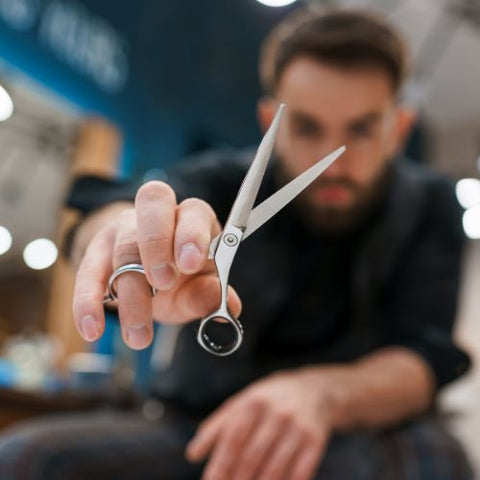Scissors are an essential tool for barbers and hairdressers. The type of blade edge on a pair of scissors can greatly affect their performance and the overall quality of the haircut. In this article, we will discuss the three main types of blade edges used on scissors for cutting hair: beveled, convex, and serrated.
Beveled edge scissors have a flat edge that is angled at the cutting point. This type of edge is the most common and is generally the most affordable. Beveled edge scissors work well for making straight cuts and are a good choice for beginners or for those on a budget.
One of the main advantages of beveled edge scissors is that they are easy to sharpen and maintain. The flat edge is simple to work with, and the angle at the cutting point allows for smooth and precise cutting. Beveled edge scissors are also generally more durable than other types of blade edges, making them a good choice for long-term use.

However, beveled edge scissors do have some limitations. Because the edge is flat, they may not work as well for cutting through thicker or more textured hair. They can also be more difficult to use for making curved or angled cuts, as the flat edge may cause the hair to slide or bunch up.
Convex edge scissors have a curved blade edge that is rounded at the cutting point. This type of edge is designed to provide more control and precision when cutting hair. Convex edge scissors are often favored by experienced barbers and hairdressers because of their ability to glide smoothly through the hair, making clean and precise cuts.
One of the main advantages of convex edge scissors is that they are extremely sharp and allow for precision cutting. The curved edge allows the scissors to glide easily through the hair, making it easier to make curved or angled cuts. Convex edge scissors are also less likely to snag or pull on the hair, which can be a common problem with other types of blade edges.
However, convex edge scissors do have some disadvantages. Because the edge is curved, they can be more difficult to sharpen and maintain. They are also typically more expensive than other types of blade edges, which can be a drawback for those on a budget.

Serrated edge scissors have a jagged or saw-like edge that is designed to grip and hold the hair while cutting. This type of edge is often used for cutting thicker or more textured hair, as the serrations help to prevent the hair from sliding or bunching up.
One of the main advantages of serrated edge scissors is that they provide excellent grip and control when cutting through thicker or more textured hair. The jagged edge helps to hold the hair in place, allowing for more precise and accurate cutting. Serrated edge scissors are also generally more durable and long-lasting than other types of blade edges.
However, serrated edge scissors do have some disadvantages. Because the edge is jagged, they can be more difficult to sharpen and maintain. They are also not as effective for making straight cuts or for cutting through finer hair, as the serrations can cause the hair to bunch up or get caught in the blade.
In conclusion, the type of blade edge on a pair of scissors can greatly affect their performance and the overall quality of the haircut. Beveled edge scissors are the most common and affordable, and work well for making straight cuts. Convex edge scissors provide excellent precision and control, but are more expensive and difficult to maintain. Serrated edge scissors are great for cutting through thicker or more textured hair, but may not be as effective for making straight cuts or for cutting through finer hair.

Ultimately, the choice of blade edge for a pair of scissors will depend on the individual preferences and needs of the barber or hairdresser. It is important to consider the type of hair being cut, the desired level of precision and control, and the overall budget when selecting a pair of scissors with the right blade edge. By understanding the pros and cons of each type of blade edge, barbers and hairdressers can make an informed decision and choose the best scissors for their needs.











